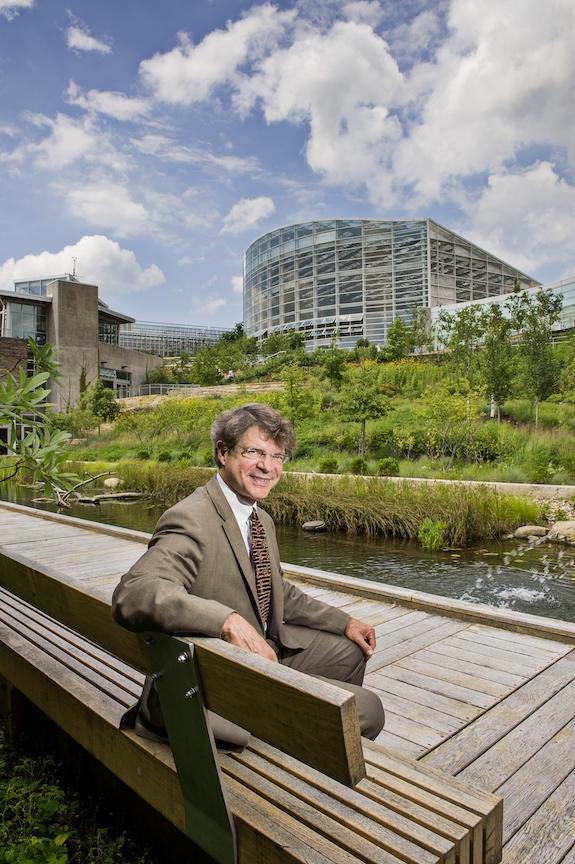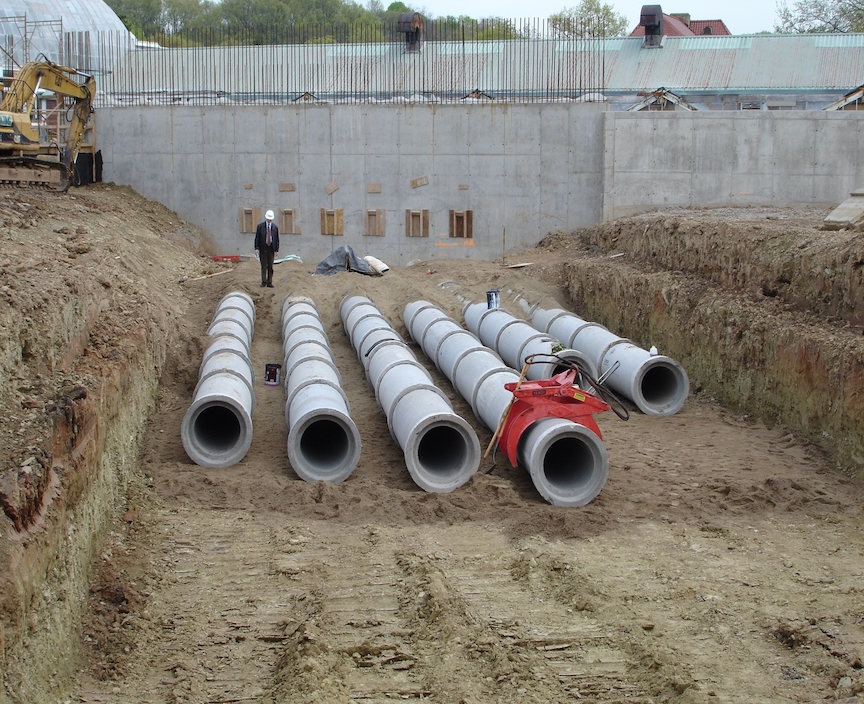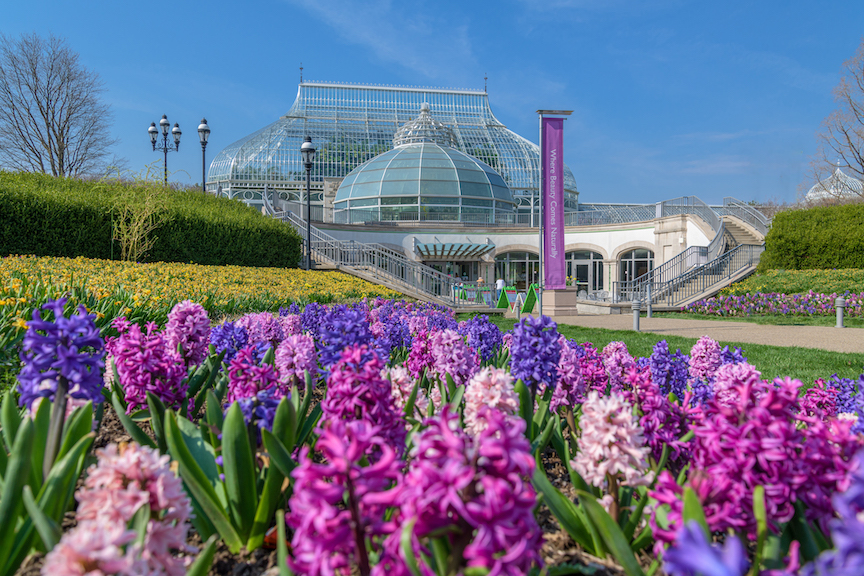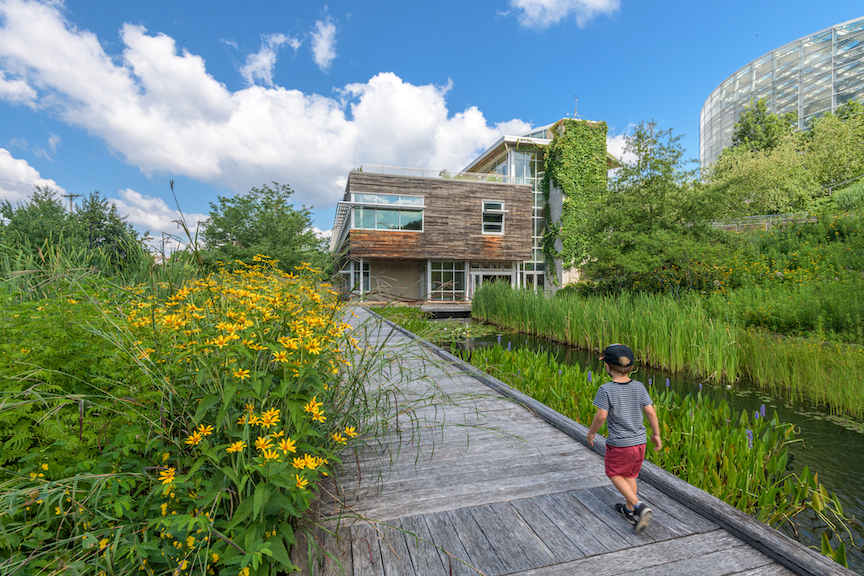
Gardening Green with Doug
A Look Back at Phipps Conservatory’s Remarkable Road to LEED-Certification with President and CEO Richard Piacentini
By Doug Oster
June 15, 2022
A house finch perches on a branch and calls for a mate, as the reflection of a water feature dances on the ceiling in a conference room at the Center for Sustainable Landscapes on the campus of Phipps Conservatory and Botanical Gardens.
President and CEO Richard Piacentini sits at the end of a long, beautiful wood table discussing the changes he’s helped create here since he arrived in 1994.
A year later he worked with his team on a new master plan “trying to figure out how to move Phipps forward into the next century,” he says.
The entrance was outdated, a small stone building off to the side that was often a source of congestion as visitors waited to enter.
“When the original conservatory was built, Piacentini says, people had different expectations than what they do today.” They didn’t mind walking single file coming in and walking out. Back then it only took about an hour to get through the building. The master plan included a new entrance, café and spacious gift shop too.
As architects were being interviewed for the project, it was Bill Mcdonough who mentioned a new thing called LEED, an anacronym for a green building certification (Leadership in Energy and Environmental Design).
He explained that buildings account for 40 percent of the energy and water use in the world and the pollution generated too.
“We said ‘Wow, we care about the environment,’” Piacentini recalls. “Why shouldn’t our buildings reflect our values?”
The epiphany changed the way the Welcome Center was going to be built and started a sort of sustainable evolution, culminating with some of the greenest buildings in the world on the campus.
As Piacentini and his team started to carefully review the checklist required to attain LEED certification, they pondered the reasons for each request. “Why are they asking us to do this?” he wondered, so they dug deeper into the checklist. “The more we learned, the more we wanted to learn and the more we wanted to raise the bar each step of the way.”
The Welcome Center became the first to be LEED certified in a public garden.
Piacentini and his team were so thrilled with this environmental milestone, that they began looking at other ways to make the campus more sustainable. The expansive front lawn was converted to organic and irrigation was ended and every aspect of what was being used throughout Phipps was reconsidered, figuring out a way to be greener.
By 2005 the entire campus was using 100 percent renewable electricity.
“Nobody was doing that back then, Piacentini says. “To us, it just made sense.”

The next phase was to create LEED certified production greenhouses, and when the team was told it was impossible to get greenhouses that sustainable, they decided to make them as green as possible.
Radiant floor heat, energy blankets, shading systems and open-roof greenhouses for cooling were used in the construction. When the greenhouses were completed, the doubters were proved wrong.
“We went back and got Platinum LEED,” Piacentini says proudly. “These were the first greenhouses to be LEED certified.”
The planned Tropical Forest and Event Center were basically a 12,000-square-foot glass box. Heating the space and cooling it conventionally is a challenge, yet trying to do the sustainably would be daunting.
Typical conservatory design uses a high vent and a low vent, when it’s hot, the vents are opened and hot air rises like a chimney.
“We wanted to figure out how to make it more efficient and be passive,” says Piacentini. He thought, instead of a high vent, what if every other row of glass on the roof could be opened.
The engineer told him he was crazy, there would be no chimney effect, to which Piacentini replied, “I don’t think the chimney effect is that great,” he recalls with a laugh.
A study of the roof idea was commissioned and it ended up that opening those panels cooled the space significantly more effectively than the conventional method.
The engineers still didn’t want to go forward with the project, pointing at an effect called “short circuit.” It’s a way that air comes in and out, circulating through the glasshouse. Piacentini new though, that’s a good thing in a tropical forest, that air circulation will be better for insect and fungal issues. The experts relented and used the system of opening part of the roof when warranted.
Then comes the saga of the earth tubes. Piacentini recounts the story, saying it’s being pretty funny now, but the installation phase of the tubes at the time must have been frustrating.
A visiting professor from Germany was brought to the site by a CMU professor to take a look at the project.
“That’s the perfect place for earth tubes,” he told Piacentini, who wondered what they were.
These tubes would be buried 15 to 20 feet deep, the air going through them is cool at that depth. But construction of the building had already started and some modifications were needed.
A new plan was put in place to add 12, 18-inch diameter pipes, stretching 300 feet from one side of the greenhouse to the other to move the cool air.
With one-third of the project completed, workers were backfilling the earth tubes as Piacentini walked the construction site. “Something’s not right, he thought to himself, repeating, something doesn’t feel right.”
“That night my wife says I woke up about two in the morning and I said, ‘they are using slag.’” His wife replied, “What are you talking about?”
He realized that they were using something called slag to backfill around the tubes, which would negatively affect their ability to cool the Tropical Forest.
“That’s like putting Styrofoam insulation around them,” he added.
After the slag was removed, he proudly walked a consultant through the project, who wondered how it was possible to use plastic tubes for ventilation, which in most communities is against code.
The consultant was right and all the tubes had to be removed, Piacentini recalls.
Now the project would switch to concrete pipe, which would add another $250,000 dollars to the budget. One problem was the concrete pipe was too big to slide into the existing holes in the walls of the Tropical Forest.
Tape measure in hand, Piacentini figured out a way to butt pipes to the existing holes, instead of inserting them, with only about a 10 percent loss in airflow.
Disaster averted and with the earth tubes in place, the building is always four to six degrees cooler than the outside temperatures.
“They use no electricity,” he says, “and there’s no greenhouse effect. It never gets hotter inside than outside.”
When asked if it’s unusual for someone in his position to be walking through the construction site, Piacentini grins and replies, “Yes, definitely.” When then asked if the contractors worry as he walks their way, he says laughing, “Probably.”
Two of the first three phases were underway, but the original plan included a new office building. As construction on the production greenhouses and Tropic Forest was moving forward, costs kept skyrocketing for various reasons, materials in particular, were going through the roof.

Piacentini went to his board and told them, “We either have to cut all the green stuff we’ve been talking about or do bare-bones buildings if we want to do all three buildings at budget.” He then made his plea to continue the sustainable construction plans. “My preference would be to do it right,” he told them, “Let’s do it green and do the first to sections the right way and put off phase three until a later date.”
“Surprisingly they agreed to do that, which I thought was incredible,” said Piacentini.
By this time, he had learned so much about green building, that he wanted this new office building, which would be eventually be named the Center for Sustainable Landscapes, to be much greener than the Silver Platinum LEED certification the plans called for.
He sketched out some ideas, how the building could collect rainwater, use solar panels and more.
At a green building conference in Denver, he showed the diagram to a friend who remarked, “That looks like a living building.” Piacentini had missed the first day of the conference where the Living Building Challenge was announced. He learned the details and realized what this new office complex could be. “I got super charged up, wow, we were already thinking about this regenerative point of view that he’s coming from.”
He called the board president saying, “We are so poised to do be able to do this, he told her, it’s the greenest kind of building you can possibly build.” But he had promised to wait on that third phase, to get the budget in shape before starting such a huge project.
Less than a month later the Tropical Forest opened in 2006 to rave reviews. Some of the movers and shakers from the foundations that helped fund the building came to see what they spent their money on and were so impressed, asked, “What’s next.” Piacentini countered with, “Well, since you asked,” and then explained the Living Building Challenge, which asks, “What if every single act of design and construction made the world a better place?”
Needless to say, he got an overwhelmingly positive response, a promise for funding and the board then agreed to move forward.
“By this time, we were really seeing how buildings affect human health,” says Piacentini. “Good air, good water, serve healthy food, ergonomics — we spend 90 percent of our lives in buildings. One area that has the biggest impact on our health is a building.”
The Center for Sustainable Landscapes has a host of green building certifications. The CSL not only was awarded the Living Building Challenge certification, LEED Platinum status but also it is the first building in the world to get four stars on SITES which later went to Platinum status. It’s a rating for environmentally-friendly landscapes. It’s the first building to be BREAAM certified, a science-based validation and certification system for sustainable building.
It's also the first building to be WELL certified, which relates to the environmental health of the structure for the people who work there.
Add three stars for FITWELL and zero energy certified and you have one of the greenest buildings in the world.
This building will be 10 years old in December,” Piacentini says. “It’s still the only building in the world to have ever met all of those certifications, it’s really remarkable.”
With every step, something new is learned and put into practice on the campus. A modular classroom was added and built to meet the standards of the Living Building Challenge.
“Children are the most vulnerable members of society, and we tend to put them in some of the worst possible buildings,” Piacentini laments. “Modular buildings are notorious for being unhealthy spaces, especially when they are brand new. They are horrible places to put a kid.”
This modular building is a healthy space for children.

When he and the team looked at a cinder block maintenance facility on the grounds, they first thought to demolish and rebuild with a green strategy in mind but decided to renovate the building.
It will soon be LEED Plantinum, is WELL Platinum certified and is being submitted to the Living Building Challenge.
“Pretty soon when those final certifications come through, we’re going to have examples of three of the greenest buildings in the world. Representing new construction, modular construction and reuse. There’s no other place like it in the world,” says Piacentini.
As he sits in the conference room in the CSL, Piacentini sees this building as a great example to show others why it’s so important to build green.
“One of the things that’s most exciting about this building is it completely turns on its head the way we need to think about sustainability,” he says.
“One of the big mistakes, when the environmental movement started, was saying you’ll have to give things up. You’re going to be freezing in the winter, hot in the summer, so stop complaining. But no one aspires to be uncomfortable,” he adds.
“If we want people to change, we need to show them it’s better. This building is zero energy, zero water building, no toxic chemicals, this is a great building to work in. That’s what we need to show people, good is better than what they have now, this is way better,” he says. “Everybody should be living or working in a building like this.”

Leave A Comment